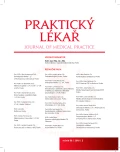Effect of compliance in self-monitoring of glycemia in type 2 diabetics treated with insulin on the disease compensation
Authors:
Ľ. Majerníková; T. Fertaľová; G. Kuriplachová; I. Ondriová
Authors‘ workplace:
Vedúca katedry: PhDr. Dagmar Magurová, PhD.
; Fakulta zdravotníckych odborov
; Katedra ošetrovateľstva
; Prešovská univerzita
Published in:
Prakt. Lék. 2018; 98(2): 83-87
Category:
Of different specialties
Overview
he aim of this study was to monitor, analyze and evaluate the differences in barriers to the implementation of self-monitoring of blood glucose among type 2 diabetics on insulin, depending of education provided to enhance compliance regarding the implementation and monitoring of glucose control after-treatment regimen. To explore attitudes about diabetes self-monitoring of blood glucose, we used a standardized questionnaire Diabetes Care Profile. The sample consisted of 411 patients with type 2 diabetes on insulin in the Presov region. Attitudes towards the need to implement self-monitoring of blood glucose of compared groups of patients differed significantly in barriers to self-monitoring (p < 0.05) and assessment of skills for coping with self-monitored blood glucose (p < 0.05) in favor of the respondents implemented to enhance the education of professionals through compliance. Correctly implemented affects the education of knowledge and skills and attitudes followed by diabetics to manage their disease.
Keywords:
compliance – selfmonitoring – education – diabetes mellitus – glycemia – barriers of self-monitoring
Sources
1. Bonomo K, De Salve A, Fiora E, et al. Evaluation of a simple policy for pre- and post-prandial blood glucose self-monitoring in people with type 2 diabetes not on insulin. Diabetes Res Clin Pract 2010; 87(2): 246–251.
2. Diabetes Control and Complications Trial Research Group. The effect of intensive treatment of diabetes on the developement and progression of long-term complications in insulin.dependent diabetes mellitus. N Engl J Med 1993; 329(14): 977–986.
3. Durán A, Martín P, Runkle I, et al. Benefits of self-monitoring blood glucose in the management of new-onset type 2 diabetes mellitus: the St Carlos Study, a prospective randomized clinic-based interventional study with parallel groups. J Diabetes 2010; 2(3): 203–211.
4. Fitzgerald JT, Anderson RM, Gruppen LD, et al. The reliability of the diabetes care profile for African Americans. Eval Health Prof 1998; 21(1): 52–65.
5. Franciosi M, Lucisano G, Pellegrini F, et al. ROSES Study Group: ROSES: role of self-monitoring of blood glucose and intensive education in patients with type 2 diabetes not receiving insulin. A pilot randomized clinical trial. Diabetes Care 2001; 24(11): 1870–1877.
6. Gurkova, E. Nemocný a chronické onemocnění. Praha: Grada Publishing 2017.
7. Gurková E, Žiaková K. Hodnotenie efektívnosti edukácie pacientov v selfmanažmente diabetes mellitus. Kontakt 2008; 10(2): 19–31.
8. Gurková E, Čáp J, Žiaková, K. Quality of life and treatment satisfaction in the context of diabetes self-management education. Int J Nurs Pract 2011; 2(2): 91–98.
9. Karter AJ, Ackerson LM, Darbinian JA, et al. Self-monitoring of blood glucose and glycemic control: the Northern California Kaiser Permanente Diabetes registry. Am J Med 2001; 111(1): 1–9.
10. Kato NK, Kato M. Use of structured SMBG helps reduce A1c levels in insulin-treated diabetic patients [abstract]. Diabetes 2011; 60(Suppl 1): A239.
11. Kempf K, Kruse J, Martin S. ROSSO-in-praxi: a self-monitoring of blood glucose-structured 12-week lifestyle intervention significantly improves glucometabolic control of patients with type 2 diabetes mellitus. Diabetes Technol Ther 2010; 12(7): 547–553.
12. Khamseh ME, Ansari M, Malek M, et al. Effects of a structured self-monitoring of blood glucose method on patient self-management behavior and metabolic outcomes in type 2 diabetes mellitus. J Diabetes Sci Technol 2011; 5(2): 388–393.
13. Kleefstra N, Hortensius J, Logtenberg SJ, et al. Self-monitoring of blood glucose in tablet-treated type 2 diabetic patients (ZODIAC). Neth J Med 2010; 68(1): 311–316.
14. Majerníková Ľ, Obročníková A, Jakabovičová A. Edukácia pacienta s diabetes. MOLISA 2007; 4(4): 113–115.
15. Mensing, C, Boucher J, Cypress M. National standards for diabetes self-management education. Diabetes Care 2000; 23(5): 682–689.
16. Murata GH, Shah JH, Adam KD, et al. Factors affecting diabetes knowledge in type 2 diabetic veterans. Diabetologia 2003; 46(6): 1170–1178.
17. Parkin CG, Buskirk A, Hinnen DA, Axel-Schweitzer M. Results that matter: structured vs. unstructured self-monitoring of blood glucose in type 2 diabetes. Diabetes Res Clin Pract 2012; 97(1): 6–15.
18. Polonsky WH, Fisher L, Schikman CH, et al. A structured self-monitoring of blood glucose approach in type 2 diabetes encourages more frequent, intensive, and effective physician interventions: results from the STeP study. Diabetes Technol Ther 2011; 13(2): 797–802.
19. Polonsky WH, Fisher L, Schikman CH, et al. Structured self-monitoring of blood glucose significantly reduces A1C levels in poorly controlled, noninsulin-treated type 2 diabetes. Diab Care 2011; 34(3): 262–267.
20. Seaquist RE, Miller ME, Bonds DE, et al. The impact of frequent and unrecognized hypoglycemia on mortality in the ACCORD Study. Diabets Care 2012; 35(2): 409–414.
21. Shiraiwa T, Takahara M, Kaneto H, et al. Efficacy of occasional self-monitoring of postprandial blood glucose levels in type 2 diabetic patients without insulin therapy. Diabetes Res Clin Pract 2010; 90(3): e91–e92.
22. Schwedes U, Siebolds M, Mertes G. Meal-related structured self-monitoring of blood glucose: effect on diabetes control in non-insulin-treated type 2 diabetic patients. Diabetes Care 2002; 25(11): 1928–1932.
23. Zeleníková R, Bužgová R, Janíková E, Jarošová D. Evaluation of quality of life of patients with diabetic foot syndrome in selected health care facilities of Moravian-Silesian region. Ošetřovatelství a porodní asistence 2014; 5(1): 2–8.
Labels
General practitioner for children and adolescents General practitioner for adultsArticle was published in
General Practitioner

2018 Issue 2
Most read in this issue
- Overview of questionnaires and scales of the quality of life and non-motor symptoms of patients with Parkinson’s disease
- Survival after resection of oesophageal cancer
- Comparison of ankle brachial index with ultrasonographic examination of lower limb arteries in diabetics
- The parent-child physical activity of Czech families with normal weight children and overweight or obese children
